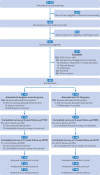Effect of laughter exercise versus 0.1% sodium hyaluronic acid on ocular surface discomfort in dry eye disease: non-inferiority randomised controlled trial
- PMID: 39260878
- PMCID: PMC12036614
- DOI: 10.1136/bmj-2024-080474
Effect of laughter exercise versus 0.1% sodium hyaluronic acid on ocular surface discomfort in dry eye disease: non-inferiority randomised controlled trial
Abstract
Objective: To assess efficacy and safety of laughter exercise in patients with symptomatic dry eye disease.
Design: Non-inferiority randomised controlled trial.
Setting: Recruitment was from clinics and community and the trial took place at Zhongshan Ophthalmic Center, Sun Yat-sen University, the largest ophthalmic centre in China, between 18 June 2020 to 8 January 2021.
Participants: People with symptomatic dry eye disease aged 18-45 years with ocular surface disease index scores ranging from 18 to 80 and tear film break-up time of eight seconds or less.
Interventions: Participants were randomised 1:1 to receive laughter exercise or artificial tears (0.1% sodium hyaluronic acid eyedrop, control group) four times daily for eight weeks. The laughter exercise group viewed an instructional video and participants were requested to vocalise the phrases "Hee hee hee, hah hah hah, cheese cheese cheese, cheek cheek cheek, hah hah hah hah hah hah" 30 times per five minute session. Investigators assessing study outcomes were masked to group assignment but participants were unmasked for practical reasons.
Main outcome measures: The primary outcome was the mean change in the ocular surface disease index (0-100, higher scores indicating worse ocular surface discomfort) from baseline to eight weeks in the per protocol population. The non-inferiority margin was 6 points of this index score. Main secondary outcomes included the proportion of patients with a decrease from baseline in ocular surface disease index score of at least 10 points and changes in dry eye disease signs, for example, non-invasive tear break up time at eight weeks.
Results: 299 participants (mean age 28.9 years; 74% female) were randomly assigned to receive laughter exercise (n=149) or 0.1% sodium hyaluronic acid (n=150). 283 (95%) completed the trial. The mean change in ocular surface disease index score at eight weeks was -10.5 points (95% confidence interval (CI) -13.1 to -7.82) in the laughter exercise group and -8.83 (-11.7 to -6.02) in the control group. The upper boundary of the CI for difference in change between groups was lower than the non-inferiority margin (mean difference -1.45 points (95% CI -5.08 to 2.19); P=0.43), supporting non-inferiority. Among secondary outcomes, the laughter exercise was better in improving non-invasive tear break up time (mean difference 2.30 seconds (95% CI 1.30 to 3.30), P<0.001); other secondary outcomes showed no significant difference. No adverse events were noted in either study group.
Conclusions: The laughter exercise was non-inferior to 0.1% sodium hyaluronic acid in relieving subjective symptoms in patients with dry eye disease with limited corneal staining over eight weeks intervention.
Trial registration: ClinicalTrials.gov NCT04421300.
© Author(s) (or their employer(s)) 2019. Re-use permitted under CC BY-NC. No commercial re-use. See rights and permissions. Published by BMJ.
Conflict of interest statement
Competing interests: All authors have completed the ICMJE uniform disclosure form at www.icmje.org/disclosure-of-interest/ and declare: support from the National Natural Science Foundation of China (82070922, 82201142) and the High-level Hospital Construction Project (303020101) for the submitted work; no financial relationships with any organisations that might have an interest in the submitted work in the previous three years; no other relationships or activities that could appear to have influenced the submitted work.
Figures


References
-
- 2022 Market Scope. Dry eye products report: a global market analysis for 2015 to 2021. St Louis: Market Scope. November, 2022.
Publication types
MeSH terms
Substances
Associated data
LinkOut - more resources
Full Text Sources
Medical
